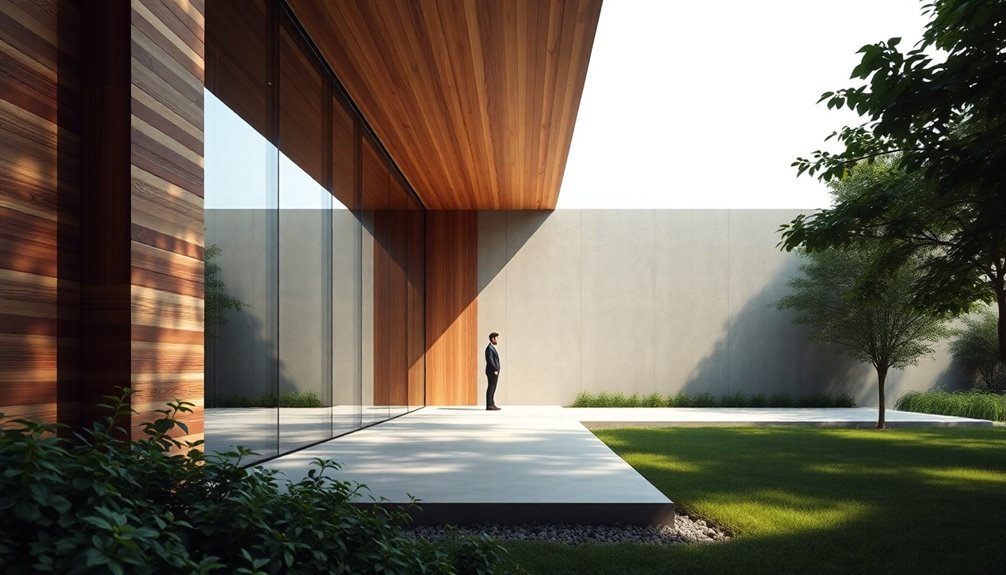Minimalist architecture evolves from a pursuit of simplicity and function, drawing inspiration from influential movements like Bauhaus and Japanese aesthetics. You'll see clean lines, natural materials, and a focus on tranquility in designs that resonate deeply with nature. Modern architects continue to shape this style, blending functionality with emotional well-being. With a rising trend towards sustainability and multi-functional spaces, the essence of "less is more" remains timeless. Discover how these elements intertwine to inspire contemporary spaces.
Key Takeaways
- Minimalist architecture emerged from modernist principles, emphasizing simplicity and functionality as seen in the Bauhaus movement and Mies van der Rohe's philosophy.
- Key characteristics include clean lines, natural materials, and a focus on negative space, creating tranquil and inviting environments.
- Influential architects like John Pawson and Tadao Ando exemplify minimalist design, merging functionality with emotional impact and a connection to nature.
- The use of glass in urban design enhances openness and energy efficiency, blurring the boundaries between indoor and outdoor spaces.
- Current trends focus on sustainability, multi-functional spaces, and smart technology, ensuring minimalist design remains relevant and inspiring in modern life.
The Origins of Minimalist Architecture
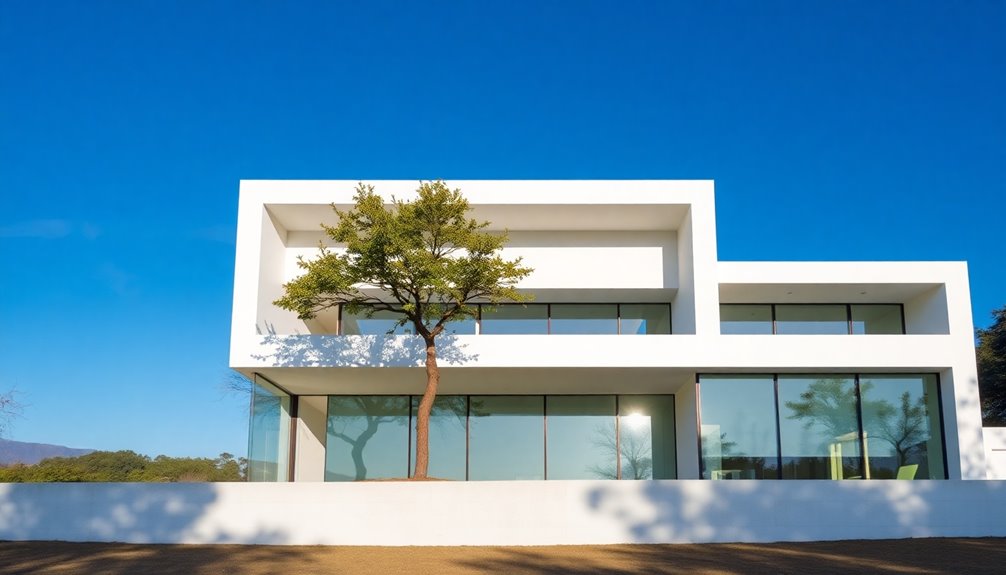
Minimalist architecture, which emphasizes simplicity and functionality, has its roots in the modernist principle of "form follows function."
As you explore its origins, you'll find that the Bauhaus movement, founded by Walter Gropius in 1919, greatly influenced its development by advocating for minimal materials and functional design.
The Bauhaus movement, founded by Walter Gropius, championed minimal materials and functional design, shaping the essence of minimalist architecture.
This approach resonated with key figures like Ludwig Mies van der Rohe, who famously coined the phrase "less is more."
The minimalist movement gained traction in the mid-20th century, paralleling a broader cultural shift towards clarity and simplicity in art and design. Additionally, the integration of natural materials in design reflects a growing appreciation for warmth and authenticity in contemporary architecture.
Key Characteristics of Minimalist Design
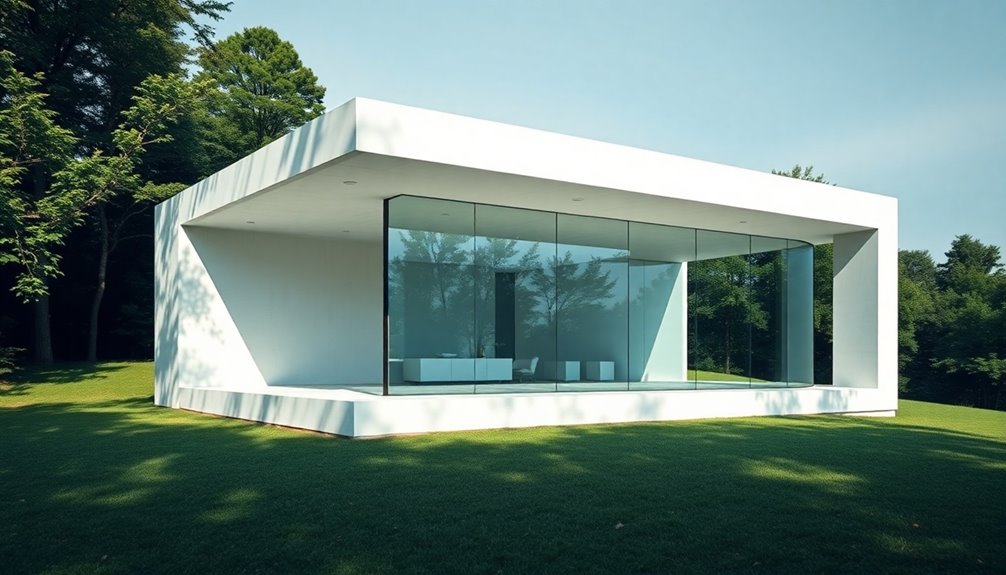
In minimalist design, you'll notice a strong focus on simplicity and functionality that creates an inviting atmosphere.
Clean lines and shapes define the space, ensuring that every element serves a purpose without unnecessary clutter.
This approach not only enhances aesthetics but also fosters a sense of tranquility. Additionally, the incorporation of natural materials helps to create a harmonious connection with the environment.
Simplicity and Functionality
When you think about minimalist design, the phrase "less is more" perfectly captures its essence, emphasizing simplicity and functionality. This approach strips away unnecessary elements, allowing spaces to breathe and serve their intended purpose.
Minimalist architecture prioritizes clarity, where every feature has a function, reflecting the modernist principle of "form follows function." Notable architects like Tadao Ando and John Pawson create environments that promote well-being, focusing on open, clutter-free areas.
The beauty of minimalist design lies in its material textures and clean shapes, which act as the primary decorative elements. By integrating Zen-inspired aesthetics, contemporary minimalism adapts to cultural and technological changes while remaining rooted in simplicity, ultimately creating spaces that are both practical and inspiring. Incorporating moisture-resistant materials in bathroom renovations can enhance durability while maintaining a minimalist aesthetic.
Clean Lines and Shapes
Clean lines and shapes form the backbone of minimalist design, creating a striking visual language that communicates clarity and purpose.
You'll notice how these clean lines emphasize simplicity, making architectural forms both functional and aesthetically pleasing. This principle of "form follows function" guarantees that every element serves a purpose, avoiding unnecessary decoration.
Prominent figures like Tadao Ando and John Pawson showcase how material textures become integral to the design, enriching rather than distracting.
Minimalist architecture often features open spaces, enhancing a sense of serenity and well-being.
Influenced by cultural elements, particularly Japanese aesthetics, minimalist design highlights the significance of space and emptiness, inviting you to appreciate the beauty in simplicity and intentionality. The concept of indoor-outdoor living is also a key aspect of creating serene spaces that encourage harmony with nature.
The Influence of Bauhaus on Minimalism
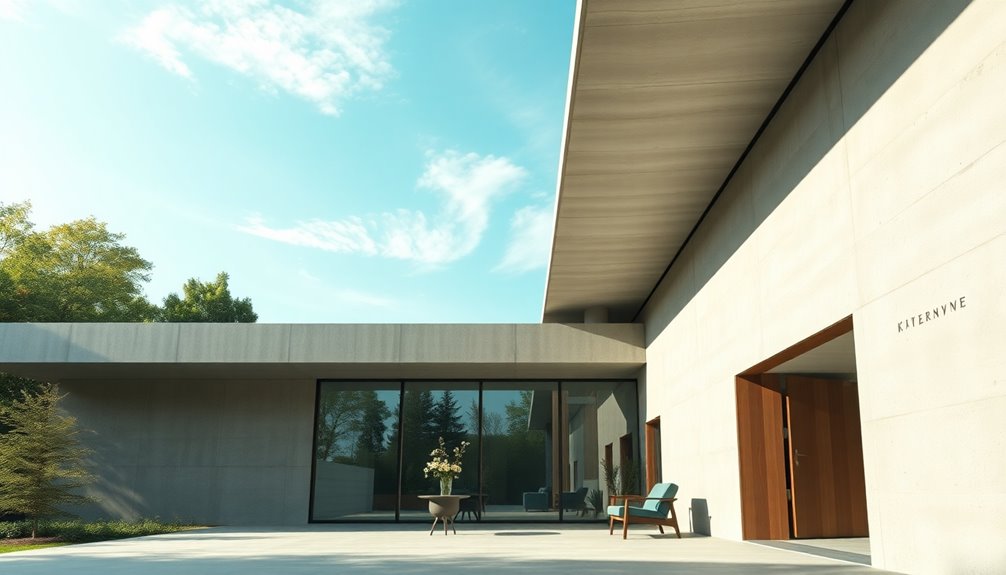
The Bauhaus School revolutionized design by prioritizing functionality and minimal materials, which set the stage for modern minimalism. You can see its influence in the sleek lines and simplicity that define contemporary architecture today. This emphasis on cognitive CQ enhances the ability to relate to diverse cultural aesthetics and design philosophies.
Bauhaus Design Principles
Minimalism in architecture owes much to the revolutionary ideas of the Bauhaus School, founded in 1919 by Walter Gropius. This movement emphasized the fusion of art, craft, and technology, laying the groundwork for minimalist design principles.
Key figures like Marcel Breuer and Mart Stam advocated for cost-effective manufacturing and portable designs, enhancing the minimalist aesthetic. They focused on using minimal materials to create slender structures, bringing lightness to space.
Ludwig Mies van der Rohe, the third director, famously coined "less is more," capturing minimalism's essence through sleek design and high-quality materials.
The Bauhaus aesthetic's emphasis on functionality without excess has had a lasting impact, reinforcing clarity and purpose in minimalist architecture today. Additionally, the principles of urban landscapes in contemporary art reflect a similar commitment to simplicity and function, demonstrating how various artistic movements can intersect with architectural design.
Impact on Modern Minimalism
While the Bauhaus School laid the groundwork for minimalist architecture, its influence continues to shape modern design practices.
You'll find that minimalist architects today draw inspiration from the Bauhaus philosophy, particularly the idea that "form follows function." This principle encourages a focus on simplicity and practicality in both architecture and interior design.
Bauhaus emphasized using minimal materials to create elegant, slender structures, a concept that persists in contemporary designs. The era's push for cost-effective manufacturing and easy maintenance promotes stylish yet functional elements in modern spaces. Additionally, the emphasis on color accuracy in design ensures that the aesthetics remain striking and true to the original vision.
As you explore minimalist architecture, you'll notice the enduring legacy of the Bauhaus, where clarity, simplicity, and essential forms remain at the forefront of innovative design.
Japanese Aesthetics and Minimalism
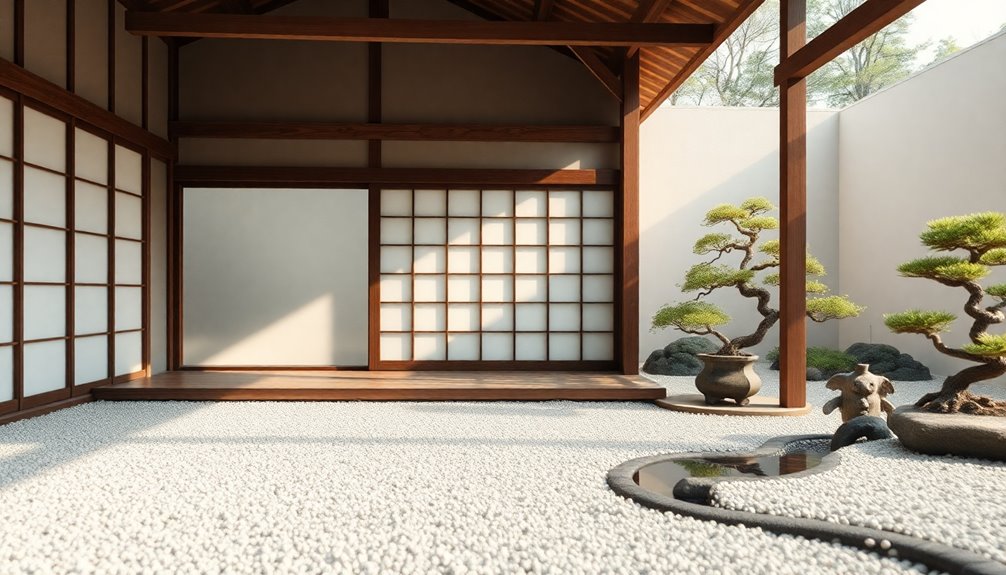
Rooted in a deep appreciation for nature, Japanese aesthetics profoundly shape minimalist architecture.
You'll find that the concept of Ma emphasizes negative space, enhancing the relationship between objects and their surroundings. This principle leads to minimalist interiors that feel both spacious and inviting.
Traditional Japanese homes utilize natural materials like wood and stone, reinforcing simplicity and harmony.
Zen philosophy further enriches these designs, fostering tranquility and mindfulness within the spaces.
Features such as sliding doors (fusuma) provide flexibility, allowing for openness and adaptability in your living environment.
Additionally, elements like shoji screens and tatami mats not only serve practical purposes but also promote a clean, uncluttered aesthetic, perfectly aligning with the core tenets of minimalism. Incorporating natural materials into your designs can create a warm and inviting atmosphere that resonates with the principles of both Japanese aesthetics and farmhouse style.
Modern Minimalist Architects and Their Impact
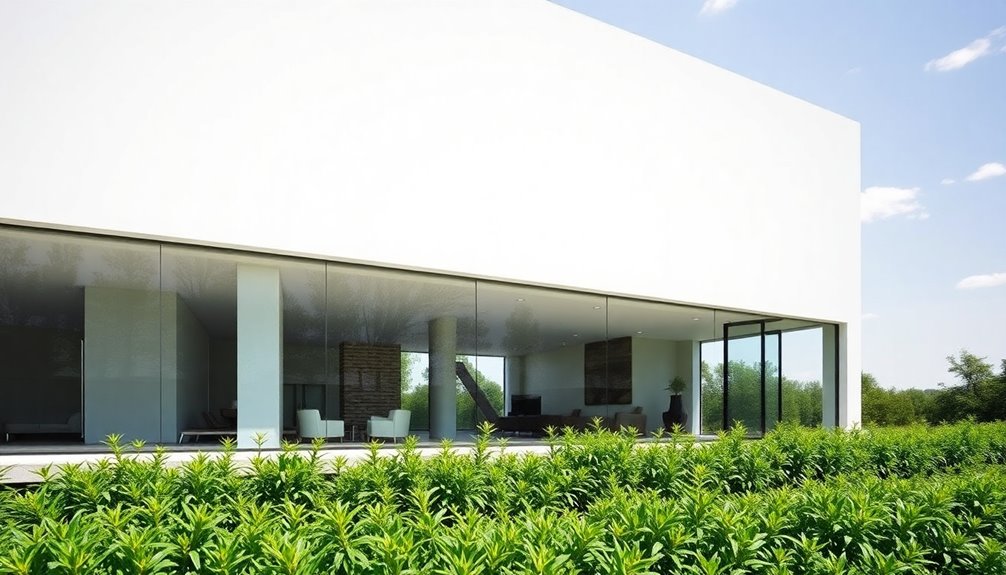
As you explore the domain of modern minimalist architecture, you'll discover architects like John Pawson and Tadao Ando, whose work exemplifies a commitment to elegant simplicity and harmonious design.
Both are pivotal figures in contemporary minimalism, focusing on maximizing openness and the interplay between interior spaces and their natural surroundings.
Pivotal figures in contemporary minimalism, they emphasize openness and the seamless connection between interiors and nature.
Pawson creates tranquil environments that promote mindfulness, while Ando's innovative use of concrete and glass enhances natural light's role in architecture.
Their emphasis on functionality and emotional impact has inspired a new generation of designers, encouraging them to prioritize harmony in their creations. Additionally, the principles of retirement planning can be applied to architectural investments, emphasizing sustainability and long-term value.
The Role of Glass in Minimalist Architecture

In minimalist architecture, glass plays an essential role in creating a sense of openness and connection to the environment. It allows natural light to flood interior spaces, enhancing the feeling of empty space. Floor-to-ceiling windows blur the lines between indoor and outdoor areas, promoting a seamless flow. Translucent and acid-etched glass can maintain privacy while minimizing visual clutter, merging functionality with beauty. Additionally, the principles of Leave No Trace are often reflected in minimalist designs, emphasizing sustainability and harmony with nature.
| Type of Glass | Benefits |
|---|---|
| Translucent Glass | Maintains privacy, reduces visual clutter |
| Acid-Etched Glass | Diffuses light, adds elegant texture |
| Floor-to-Ceiling | Enhances spatial perception |
| Glass Doors | Promotes a clean, light-filled atmosphere |
Minimalism in Urban Design

Minimalist architecture extends its principles into urban design, where the focus on simplicity and functionality marries well with the demands of city living.
Minimalist architecture enhances urban design, blending simplicity and functionality to meet the needs of modern city living.
By incorporating glass elements, urban spaces achieve a balance of aesthetics and practicality.
Here are some key features of minimalism in urban design:
- Glass partitions maximize natural light and create open interiors.
- Sandblasted glass walls provide privacy while enhancing visual appeal.
- Floor-to-ceiling windows offer stunning city views and an expansive feel.
- High-rise buildings use glass doors to blur indoor-outdoor boundaries.
- These features promote energy efficiency by reducing reliance on artificial lighting.
This approach not only transforms urban landscapes but also enriches the interior experience, making city life feel more connected and spacious.
Future Trends in Minimalist Architecture

While the future of architecture evolves, minimalist designs are set to embrace sustainability and emotional well-being more than ever. You'll see a rise in nature-infused minimalism, which integrates biophilic design principles, fostering harmony between indoor and outdoor spaces. Additionally, smart home technology will redefine the nature of design, enhancing functionality while preserving clean aesthetics. Multi-functional spaces will also gain importance, adapting to your dynamic lifestyle needs.
| Trend | Description | Impact on Design |
|---|---|---|
| Sustainability | Eco-friendly materials and practices | Reduces ecological footprint |
| Emotional Well-Being | Spaces promoting mental health | Enhances overall living experience |
| Multi-Functional Spaces | Adaptable environments | Meets various lifestyle demands |
| Nature-Infused Minimalism | Blending indoor and outdoor elements | Creates harmonious living spaces |
| Smart Home Technology | Responsive designs for minimalist interiors | Boosts functionality |
The Timeless Appeal of Minimalist Design
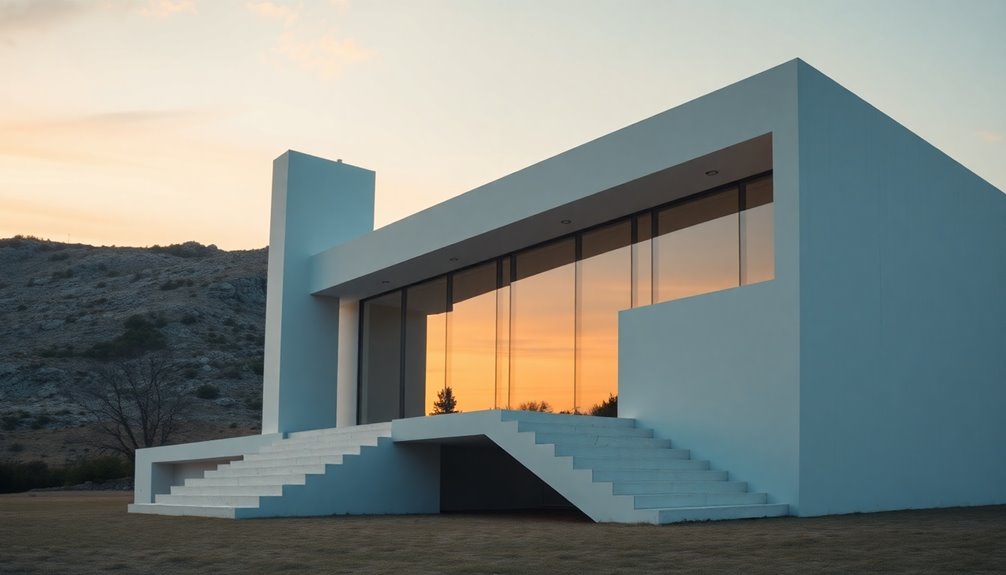
Embracing simplicity can transform your living space into a sanctuary of calm and clarity.
Minimalism, with its focus on functionality and clean lines, offers a timeless appeal that resonates with many. Architects incorporate this design philosophy, ensuring it remains relevant across generations.
Minimalism emphasizes functionality and clean lines, creating a timeless allure that speaks to generations.
Consider these key aspects of minimalist design:
- Less is more: A principle highlighted by Ludwig Mies van der Rohe.
- High-quality materials: Used to create refined and durable spaces.
- Clutter-free environments: Promote serenity and well-being.
- Adaptability: Evolves with cultural and technological changes.
- Aesthetic pleasure: Balances the chaos of modern life.
Frequently Asked Questions
What Is the Evolution of Minimalism?
Minimalism has evolved from its post-World War II roots, prioritizing simplicity and functionality.
You'll notice its influence in art and design, emphasizing "less is more."
As you explore its journey, you'll see how Japanese aesthetics and modern technology shaped minimalist principles.
Today, minimalist design focuses on sustainability and emotional connection, urging you to appreciate space and clarity in your surroundings.
Ultimately, it's about creating a meaningful experience through reduced excess.
What Was Minimalism Inspired By?
Think of minimalism as a clear, tranquil pond, reflecting simplicity and purpose.
It was inspired by the Bauhaus movement, which blended art, craft, and technology, emphasizing functionality without sacrificing beauty.
The Minimal Art movement of the 1960s, with figures like Donald Judd, focused on reducing form and using fewer objects.
Japanese aesthetics, especially the concept of Ma, highlighted the significance of space, while Adolf Loos' ideas encouraged plain surfaces and honest materials.
What Is the Origin of Minimalist Architecture?
Minimalist architecture originated from the modernist movement, focusing on simplicity and functionality.
You'll find that key influences include the Bauhaus School, which integrated art and design, and figures like Ludwig Mies van der Rohe, who popularized the phrase "less is more."
Post-World War II developments in Minimal Art and Japanese design principles also shaped its evolution, emphasizing essential qualities and the importance of space.
This blend creates the timeless appeal of minimalist architecture.
What Is the Impact of Minimalist Design?
Imagine your home as a calm lake, reflecting tranquility.
Minimalist design impacts your life by clearing the clutter, allowing clarity in your surroundings. It uses high-quality materials, ensuring your space remains timeless and durable.
As you embrace simplicity, you find functionality that adapts to your needs. Natural light pours in, connecting you to the outdoors, while sustainable practices minimize your environmental footprint.
In this serene environment, you thrive and feel more balanced.
Conclusion
To sum up, minimalist architecture isn't just about empty spaces; it's about creating a sense of calm and clarity. Some may argue that minimalism feels too stark or cold, but it's precisely this simplicity that fosters a deeper connection to the environment and encourages mindfulness. By embracing minimalism, you invite inspiration and tranquility into your life, proving that less truly can be more. So, don't shy away from minimalism—let it transform your space and perspective.
